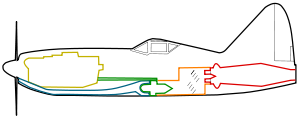- Motorjet
-
"Thermojet" redirects here. For the type of pulsejet, see pulse jet engine.
Motorjet Main components of motorjet-powered aircraft; the propeller is absent on some designs Part of a series on
Aircraft propulsionShaft engines (to drive propellers, rotors, ducted fans, or propfans) - Internal combustion engines:
- Piston engine
- Wankel engine
- Turbines:
- External combustion engines:
- Others:
Reaction engines A motorjet is a rudimentary type of jet engine which is sometimes referred to as thermojet, a term now commonly used to describe a particular and completely unrelated pulsejet design.
Contents
Design
At the heart the motorjet is an ordinary piston engine (hence, the term motor), but instead of (or sometimes, as well as) driving a propeller, it drives a compressor. The compressed air is channeled into a combustion chamber, where fuel is injected and ignited. The high temperatures generated by the combustion cause the gases in the chamber to expand and escape at high pressure from the exhaust, creating a thermal reactive force that provides useful thrust.
Motorjet engines provide greater thrust than a propeller alone mounted on a piston engine; this has been successfully demonstrated in a number of different aircraft.
History
- In 1908 French inventor René Lorin proposed using a piston engine to compress air that would then be mixed with fuel and burned to produce pulses of hot gas that would be expelled through a nozzle to generate a propelling force.[1]
- In 1917, O. Morize of Chateaudun, France, proposed the Morize ejector scheme in which a reciprocating engine drove a compressor supplying air to a liquid fueled combustion chamber which discharged into a convergent-divergent tube and ultimately out into the atmosphere.
- The term "motor jet" was established in a patent filed in Britain by J.H. Harris of Esher, U.K., in 1917.
- It was next explored by Secondo Campini in the early 1930s, although it was not until 1940 that an aircraft, the Caproni Campini N.1 (sometimes referred to as C.C.2), would fly powered by his engine. Campini established the misnomer thermojet at this time to describe his motorjet.
- NACA engineer Eastman Jacobs was actively pursuing thermojet research in the early 1940s for a project that came to be known as Jake's jeep but which was never completed as turbojet technology overtook it.
- Japanese engineers developed the Tsu-11 motorjet engine to power Ohka aircraft as an alternative to the solid-fuel rocket engines that these aircraft were then using.
- The Soviet Mikoyan-Gurevich I-250 (N) designed in 1944 used a piston engine to drive both a propeller at the nose of the plane, and a motorjet compressor leading to a jet exhaust at the tail. Between 10 and 50 I-250 (a.k.a. MiG-13) aircraft were produced, serviced, and flown by the Soviet Navy through 1950.
- Canadian inventor Mark Nye (Nye Thermodynamics Corporation) built a successful thermojet based on a single stage axial fan of his own design driven by a V6 automobile engine in 2002. The jet pipe consisted of three 45 gallon drums welded together with a cable operated variable area nozzle and a fabricated flame holder. This gasoline fueled, 85 lbf (0.38 kN) thrust design was as used to power his three wheeled dragster to victory on Discovery’s JunkYard Wars in Los Angeles in August 2002.
Motorjet research was nearly abandoned at the end of World War II as the turbojet was a more practical solution to jet power as it used the jet exhaust to drive a gas turbine, providing the power to drive the compressor without the additional weight of a piston engine that generated no thrust. One of the primary advantages of the motorjet layout was that the reciprocating engine provided power for the compressor and no turbine power section was needed. However, the metallurgy and understanding of the design of turbines had advanced to the point after WWII where it was feasible to create a turbine to operate reliably in the high velocity hot gas environment downstream of the combustor and the motorjet idea lost focus.
Notes
External links
Lists relating to aviation General Aircraft (manufacturers) · Aircraft engines (manufacturers) · Airlines (defunct) · Airports · Civil authorities · Museums · Registration prefixes · Rotorcraft (manufacturers) · TimelineMilitary Accidents/incidents Records Categories:- Jet engines
- Motorjet engines
- Internal combustion engines:
Wikimedia Foundation. 2010.

